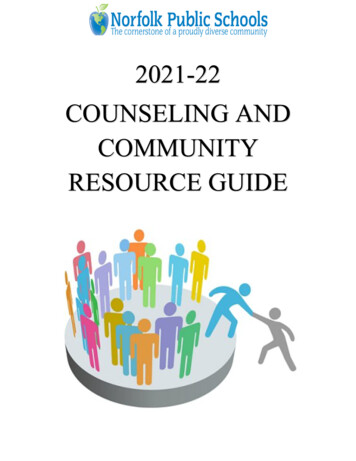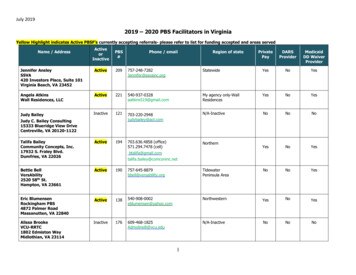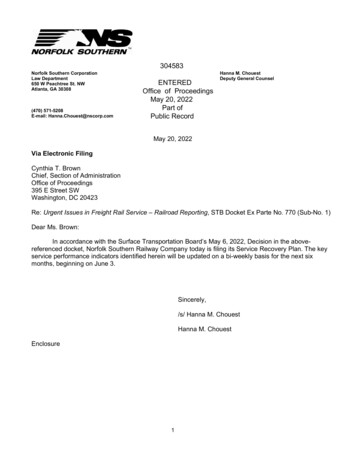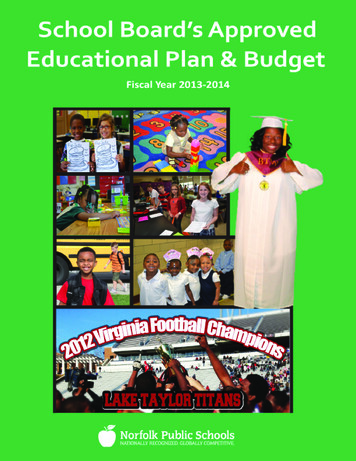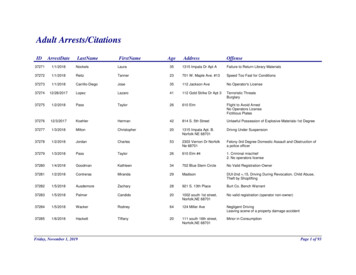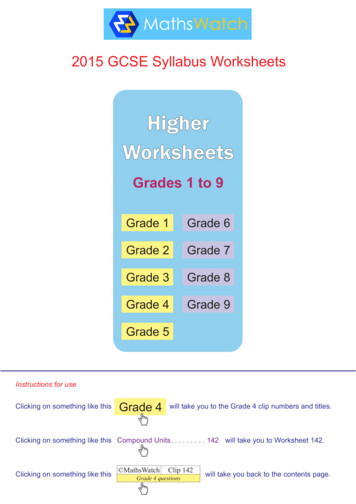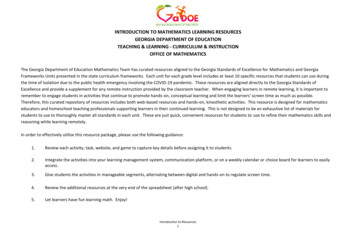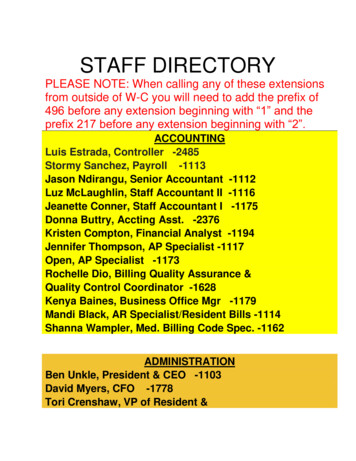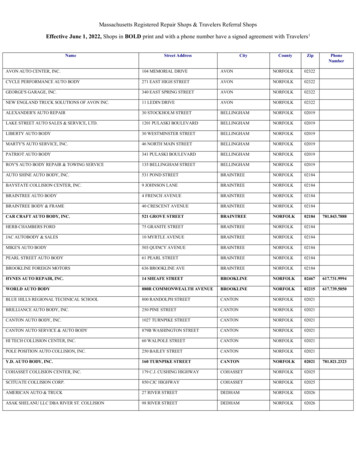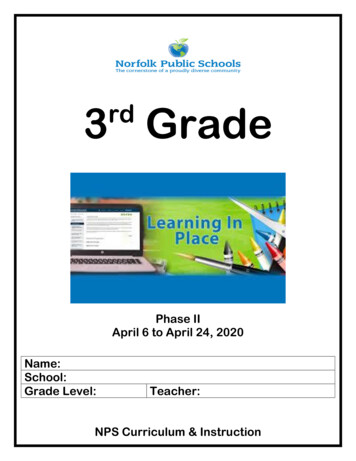
Transcription
rd3 GradePhase IIApril 6 to April 24, 2020Name:School:Grade Level:Teacher:NPS Curriculum & Instruction
Social Studies Learning in Place PlansThird Grade: April 6-10Learning Experience 1Learning Experience 2Africa is an interesting place to visit and live.Look at the Geography of Africa fact sheet andpictures. Decide which information you find themost interesting.Choose one of the following activities tocomplete using the Geography Fact Sheet:1. Design a flyer or advertisement to convincesomeone to visit Africa. Include facts aboutAfrica and places they should see on their trip.2. Pretend you visited Africa. Write a journalentry or letter home describing what you havelearned and seen on your trip.Use the world map to label the continents foreach of the Ancient Civilizations learned so farthis year.o Ancient Egypto Ancient Chinao Ancient Greeceo Ancient RomeLearning Experience 3Create a Venn Diagram on a sheet of paper. Compareand contrast the features and location of thecontinent of Africa with another continent you havelearned about this year. You may use the ContinentEssential Knowledge sheet in your packet to help you.Remember what the continents have in common (orsimilar) goes in the center.In the space under the map, answer the followingprompt:Which continent would you like to visit? Write aparagraph to describe the landforms you wouldsee and provide other reasons for why you wantto visit. You may use the Continent EssentialKnowledge sheet in your packet to help you.Social Studies Learning in Place PlansThird Grade: April 20-24Learning Experience 1Look at the map Africa From the Beginning toToday in your packet. Read the map key andlocate each place on the map. Then read thecaptions about ancient Mali at its peak and Malitoday. Using your background knowledge, thecaptions, and the map write 2 -3 sentencescomparing ancient Mali at its peak and Malitoday. Discuss the locations, how life isdifferent, and any other interesting information.You may write your sentences next to the map.Learning Experience 2Use the map from Learning Experience 1 to helpyou complete the Map of Mali Then and Nowactivity sheet (Reproducible 88).Learning Experience 3Use the map from Learning Experience 1 to answerthese questions. Put your answers on the map sheet.1. Which body of water do you think Europeans mostoften cross to trade gold in Mali?2. When was Mali the largest?3. Which statement describes Mali today?A. It stretches further north than ancient Mali.B. It touches the Atlantic Ocean.C. It touches the Red Sea.D It stretches into east Africa.
Geography of Africa (Source: Ducksters)The continent of Africa borders Mediterranean Sea. The Atlantic Ocean is to the west and theIndian Ocean is to the Southeast. Africa is the world's second largest continent.Africa has a wide variety of landforms, wildlife, and climates.Population: 1,022,234,000 (Source: 2010 United Nations)Area: 11,668,599 square milesRanking: It is the second largest and second most populated continent. (That means a large number of people live there!)Major Landforms: desert, savanna, rain forestMajor cities: Cairo, EgyptLagos, NigeriaCape Town, South AfricaDurban, South AfricaBordering Bodies of Water: Atlantic Ocean, Indian Ocean, Red Sea, Mediterranean Sea, Gulf of GuineaMajor Rivers and Lakes: Nile River, Niger River, Congo River, Zambezi River, Lake Victoria, Lake Tanganyika, Lake NyasaMajor Geographical Features: Sahara Desert, Serengeti grasslands, Atlas Mountains, Mount Kilimanjaro, Madagascar Island,Nile RiverAtlas MountainsSahara Desert
Learning Experience 1: Use the letters to labelthe locations of the Ancient Civilizations on themap:A. EgyptName of continent?B. ChinaName of continent?C. Greece and RomeName of continent?
1. Draw a compass rose on the map. If I traveled fromEgypt to Timbuktu, what direction would I go?2. Using your background knowledge, the captions, andthe map write 2 -3 sentences comparing ancient Maliat its peak and Mali today. Discuss the locations, howlife is different, and any other interesting information.Write the answers for Learning Experience 3 here:1.2.3.
NPS Learning in Place EnglishGrade: Third GradeMondayRead passage “Moose onthe Move!”Complete a main idea anddetails map about thepassage.TuesdayRead “Whoop It Up”Complete a main idea anddetails map about thepassage.WednesdayReread “Moose on theMove!” and “Whoop It Up”Complete the Venndiagram comparing thetwo articles.Week4Write an explanationexplaining how wildlifeofficials are working tosolve the problem of notenough food.Week5Week6ReadMaterialsWrite an explanation ofwhy scientists are usingOperation Migration.ThursdayRead How the Empire ofMali ChangedSocial Studies text pp128129Write 5 questions that canbe answered using only thetext features.FridayReread How theEmpire of MaliChangedSocial Studies textpp128-129Write a paragraphexplaining why Malideclined. Make sureyou give 2 reasons.Write an explanation ofhow the officials in “Mooseon the Move!” and“Whoop It Up” are alike.Spring Break: April 13 through 17, 2020Read “All in a Week”using the strategy ofvisualizing while you read.Label your visualization.Think about things thatyou do or would like to do.Make a list by the days ofthe week. ExampleMonday-swimReread “All in a Week” andanswer the comprehensionquestions.Write a poem using yourprewrite from yesterdayabout your week using theformat of “All in a Week”to guide you.Read “Kittens” using thestrategy of visualizing whileyou read. Label yourvisualization.Write a poem about ananimal. Use the format of“Kittens” to guide you.Read a book of choice and record it on the reading log each day.Reading Log/ Book of Choice to read each day/ paper /pencilsReread “Kittens” andanswer the comprehensionquestions.Write a paragraph tellingthe theme of the poem.Use the poem to provideevidence of the theme.Read “I Saw MyTeacher on aSaturday” and answerthe comprehensionquestions.Write a story or poemabout running intoyour teacher at thestore.
READ 14.2 READING LOGDate3-12-20Number ofPages rincelosesshoeandliveshappilyeverafter
Math PacingMondayTuesdayWednesdayThursdayFridayWeek 13.1 Notes3.1 TEI3.1 Checkpoint#s 1-53.1 Checkpoint #’s6-103.1 FormativeAssessmentWeek 23.2 Notes3.2 TEI3.2 Checkpoint#s 1-53.2 Checkpoint #’s6-103.2 FormativeAssessmentTensOneSOL 3.1 Notes and PracticePlace Value ChartHundredTenThousandsThousandsRounding on a Number LineThousands1. What is the value of 5 in the numeral 856,127?ABCD55050050,000Hundreds2. What does the 4 represent in the numeral124,789?ABCD4404004,0003. There are eighty-two thousand twelve seats in4. There were 504,609 people who came to thethe stadium. How would you write this numeral?concert. How do you read this number?ABCD82,1282,0128128,012ABCD5. There are 23,668 buttons in a jar. What is thatnumber rounded to the nearest hundredbuttons?ABCDfive hundred thousand, six hundred ninefive zero four thousand, six zero ninefive hundred four thousand, six hundred ninefive hundred four, six hundred nine6. Which is the greatest number?A 5073 rounded to the nearest tenB 4743 rounded to the nearest hundred23,00023,60023,70024,000C 5851 rounded to the nearest tenD 5706 rounded to the nearest hundred7. Which set of numbers in in order from least togreatest?8. Which digit goes in the box to make this a truestatement?A 59517441630048,276 4B 539166007841C 745160705991D 600374155931ABCD10699876SOL 3.1
SOL 3.1 Technology Enhanced Items (TEI)1. How is “four hundred thirty-two thousand, twenty-seven” written in standard form?2. How is “three hundred fifty-six thousand, four hundred three” written in standard form?3. Directions: Look carefully at the number below. Round this number to the nearest hundred. Circle the correctanswer from the choices in the shaded box below.4,5634,0004,6004,5004. Directions: Read the number below to yourself. Identify the place value of each digit in the number. Use theterms on the right to complete the box next to each digit of the number shown.473,5024ones7hundred thousandsthousands3tens5hundreds0ten thousands25. Directions: Look at both numbers shown below. Circle the number that is the least.4,6094,0696. Directions: Look at the two numbers in each box below. Write , , or on the blank line between the twonumbers to make each a true statement.6,4687,4868,0158,05122,7502,750SOL 3.1
3.1 Checkpoint Questions1Which shows 125,074 written in expanded form?ABCD2Which shows 125,374 written in word form?FGHJ3100,000 20,000 5,000 700 4100,000 20,000 5,000 70 4100,000 2,000 500 70 4100,000 20,000 5,000 700 40One hundred and twenty-five thousand and three hundred and seventy-fourOne hundred twenty-five thousand and three hundred seventy-fourOne hundred twenty-five thousand, three hundred seventy-fourOne hundred and twenty-five thousand, three hundred and seventy-fourDirections: Write your answers in the boxes.What is the place value position for the digits 7 and 0 in this number?267,103The place value position for the digit 7 isThe place value position for the digit 0 is4Directions: Circle each box you want to select. You must select all correct answers.Circle all the numbers that represent 563.5Directions: Write your answer in the box.Sara recycled 3,761 cans. What is 3,761 rounded to the nearest thousand?3SOL 3.1
6Melissa saved 8,607 pennies last year. Round the number of pennies Melissa saved last year to thenearest ten.ABCD7Bob sold 4,984 hats in his store last year. What is 4,984 rounded to the 4,9804,000Directions: Circle each box you want to select. You must select all correct answers.Which numbers are greater than 8,349?9Which is true?ABCD8,799 8,9795,233 5,3222,140 2,1641,899 1,98910 Directions: Write each number in the correct box. Order these numbers from least to greatest.4SOL 3.1
3.1 Formative Assessment1. The place value model shown represents a number.What number is represented by this place value model?A3,253B3,263C2,359D2,3622. Which shows the number 85,430 in word form?Aeighty-five and four hundred threeBeight five hundred, forty threeCeighty-five thousand, four hundred thirtyDeighty-five thousand, four hundred three3. Complete each box in the table.NearestThousandRound 5,647 to the nearest places shown.NearestHundredNearestTen4. Select the symbol that will make this number sentence true. 2,288 2,199 5. Put the numbers in order from greatest to least.876,497876,479875,0325SOL 3.1
SOL 3.2 Notes and PracticeA fraction is a way of representing part of a whole (as in a region/area model or a measurement model) or part of agroup (as in a set model). Fractions are used to name a part of one thing or a part of a collection of things.This is a whole with 1 shaded.This is a group with 2 shaded.43(Region/area model)(Set model)This linear model shows the mixed number 1 5 representing the shaded cubes.10The measurement model could use measuring cups, rulers, or number lines.The fractional parts are not always congruent and could have a different shape as shown in the examples.Compare fractions using pictures or words (with the same or different denominators):11 2311 10411 8811½ is greater than 1/3/10 is less than ¼/8 is equal to 1/89. Which model represents the fraction 3/8?10. What mixed number represents the shaded part ofthe ruler?ABCD11. Two sets of circles are shown.Which of the following correctly compares the fractionof circles shaded in Set S to the fraction of circlesshaded in Set T?A 3/11 7/11C 3/11 4/11B 8/11 7/11D 3/11 4/11A2B2C3D412. This model is shaded to represent one whole.Look at the following model.What number do the shaded parts in this modelrepresent?A 1/126B11/12C11/2D13/2SOL 3.1
SOL 3.2 Technology Enhanced Items (TEI)1. Directions: Write your answer in the box.Look carefully at the model shown below. Determine the fraction of the shaded part of the large rectangle.2. Directions. Circle the box with the correct answer.Look carefully at the shape below. Determine the fraction of the shaded part of the shape.01110212223. Directions: Circle the model that shows the correct answer.𝟑𝟒Find a square with parts shaded.4. Directions: Write a fraction in the empty box with your answer.Look carefully at the model shown below. Determine the shaded part of the circle.5. Directions: Write your answer in the empty box.Look carefully at the shaded part of each model. The rectangle on the left is the same size as the rectangle on theright. In the box, write the symbol , , or to make a true statement based on the drawing.6. Directions: Write your answer in the empty box.Carefully look at the shaded part of each circle. Write the symbol , , or to compare the circles and make a truestatement.7SOL 3.1
13.2 Checkpoint QuestionsThis model is shaded to represent one whole.What fraction does this model represent?3A1B185C 113216165D 18Directions: Write your answer in the box.What fraction of this set of blocks isshaded?3What fraction is represented by point C on this number line?5F95G486HJ968Directions: Draw a point on the number line to show your answer.Draw a point on the number line to represent ½.5Directions: Color each part you want to shade.Shade this set of circles to show .4/98SOL 3.1
6Directions: Color each part you want to shade. Write your answer in the box.This picture is shaded to represent one whole.9SOL 3.1
3.2 Formative Assessment1. This model is shaded to represent one whole.Look at the following model.What number do the shaded parts in this model represent?A122B152C52. In which group are exactly4625122D15of the shapes circles?ABCD3. This model is shaded to show one whole.1Shade the following pieces to show 1 .34. Two number lines are shown.Number line ANumber line BWhich of the following correctly compares the fraction on the number line A to the number line B?A3 2B2 3C1 2 D3 24 55 52 54 55. Two shapes are shaded below. Complete the box with the correct symbol to make the statement true.10SOL 3.1
Norfolk Public SchoolsScience Learning in Place Plan: Grade 3 LessonsWeek 4: April 6 – 10, 2020MondayWhat is Science?pg. 4-5 Active Reading Look for a QuestionTuesdayGetting Answerspg. 8-9 Active Reading PredictWednesdayThursdayStudents will answer thefollowing questions in theirscience notebooks:1. Why use predictions wheninvestigations betteranswer questions?2.Predict what will happen ifyou forget to water theflowers and it does notrain?Show Me the Evidencepg. 34-35 Active Reading QuestionFridayCareers in Sciencepg. 47-48 Be a Meteorologist1-6Week 5: April 13 – 17, 2020MondayTuesdayWednesdayS p r i n gThursdayFridayB r e a kWeek 6: April 20 – 24, 2020MondayTuesdayWednesdayThursdayFridayHow do Scientists Use Tools?pg. 17 Engage Your Brain! Active ReadingMake it Clear!pg. 18-19Active ReadingQuestionMeasure It!pg. 20-21Active ReadingTime and Temperaturepg. 22-23 QuestionSum It Up!pg. 26 Do the MathOptional Lesson ExtensionComplete this extension activityonly if a rule is available.However, it is not mandatory.Apply Conceptspg. 28
Elementary Art-Learning in Place PacketGrades 2-3Grades 2-3April 6.April 20.Go outside and find leaves.Place the leaves under yourpaper. Turn your crayonhorizontal and create a leafrubbing. Completemultiple leaf rubbings onyour paper in differentcolors. If you havewatercolors, wash themover the leaf rubbing for awax resist technique.Draw the first letter of yourfirst name to fill the entiresheet of paper. Usecrayons, markers, coloredpencils or watercolors to fillthe (positive space) of yourletter with color andpattern. If you choose tocolor your background(negative space), chooseone solid color.April 6- April 24, ternColorLinePositive SpaceNegative Space
MUSIC3rd Grade Learning in Place April 6-10Name TeacherLearning in Place
MUSIC3rd Grade Learning in Place April 20-24Name TeacherLearning in Place
Grade 3: Gifted OpportunitiesGifted Education & Academic RigorApril 6 – April 24Communication SkillsComplete the activity for each week. Please complete your responses on your own paper, and beready to share the answers with your Gifted Resource Teachers when you see them.Week 1April 6 - 10Invent a new animal -- Describe what it looks like, what it sounds like, how itmoves, and what it eats. Is it scary or cuddly or something else altogether? Wouldit be a pet or live in the wild (or in a zoo)? Your description should be at least 1page in length and include a picture of your animal.Week 2April 13 - 17SPRING BREAK. Enjoy and have fun! Dance to your favorite songs, take a walkoutside and look for rabbits, feel the sunshine on your face!Week 3April 20-24About My Book1. Choose any book to read.2. Draw a detailed picture of your favorite part of the story.3. Now decide how you would like to be involved in this part of the story and addyourself to the picture.4. In writing, tell what caused you to become part of the story and how youchanged this particular event.Don’t forget to read everyday!!MathematicsComplete the activity for each week. Please complete your responses on your own paper, and beready to share the answers with your Gifted Resource Teachers when you see them.Week 1April 6 – 10Extra Snack Bars. There are two hundred ninety-eight first graders in the school.There are three hundred two second graders in the school. Each student will eatone snack bar for snack. Ms. Mason has two hundred fifty snack bars. Mr. Wilsonsays he can give Ms. Mason the extra snack bars so that every student can have asnack. How many extra snack bars does Mr. Wilson give Ms. Mason? Show all yourmathematical thinking.Week 2April 13 - 17SPRING BREAK –Have FUN with your family, play chess or Life, go outside andcount how many squirrels you see running through your yard!Week 3April 20-24Walking Dogs. Joe has a dog-walking business. Joe needs to walk a total of fortyeight dogs. Joe only has thirty leashes. What are three ways Joe can walk theforty-eight dogs in equal size groups? Show all of your mathematical thinking.
NPS ESL Learning in Place Plan, Grade 3-5, April 6-10, 2020Topic: JobsBankerCashierDoctorNurseTeacherWaiter Directions : Use notebook paper to complete these learning activities.MondayPoint to each picture aboveand say the words 3 times.Think of 2-3 other jobs. Draweach job and label.Example :TuesdayWednesdayThursdayFridayWatch a movie or TVshow. What jobs didyou see in the movie orTV show?Read a book ormagazine in English oryour home language.What jobs did you readabout?What jobs do you do athome to help yourfamily?Ask your familymembers what jobsthey do. (Mom, what isyour job?)Write 2-3 sentences: Iwatched , and Isaw a .RooferExample : I watched TheCat and The Hat, and Isaw a roofer .Write 2-3 sentencesand draw a picture forWrite 2-3 sentencesTalk to a family member each sentence: At home and draw a picture forabout the jobs you read I .each sentence: Myabout.is a .Example : At home IExample : I read about a wash the dishes .Example : My mom is aroofer. A roofer fixeschef .leaks on houses.
NPS ESL Learning in Place Plan, Grade 3-5, April 20-24Topic: Job LocationsBankA banker works ata bank .Shopping CenterA cashier worksat a shoppingcenter .HospitalOffice BuildingA doctor works ata hospital or anoffice building .A nurse works at ahospital or anoffice building .SchoolRestaurantA teacher works at A waiter works ata school .a r estaurant .Directions : Use notebook paper to complete these learning activities.MondayPoint to each pictureabove and read eachsentence 3 times.Think of 2-3 other joblocations. Draw each joblocation and label.TuesdayWednesdayWatch a movie or TVshow. What job locationsdid you see in the movieor TV show?Read a book or magazinein English or your homelanguage. What joblocations did you readabout?Write 2-3 sentences: Iwatched . Aworks at a .Example :Example: I watchedWord Girl . A librarianworks at a library .libraryTalk to a family memberabout the job locationsyou read about.Example : I read about alibrary. A library hasbooks and magazines forpeople to read.ThursdayFridayThink about where youdo your jobs at home.Ask your family memberswhere they work.Write 2-3 sentences anddraw a picture for eachsentence: I in the.Write 2-3 sentences anddraw a picture for eachsentence: My is a, and he/she worksat a .Example : I wash thedishes in the kitchen .Example : My mom is achef , and sheworks at arestaurant .
1. How is "four hundred thirty-two thousand, twenty-seven" written in standard form? 2. How is "three hundred fifty-six thousand, four hundred three" written in standard form? 3. Directions: Look carefully at the number below. Round this number to the nearest hundred. Circle the correct answer from the choices in the shaded box below .
